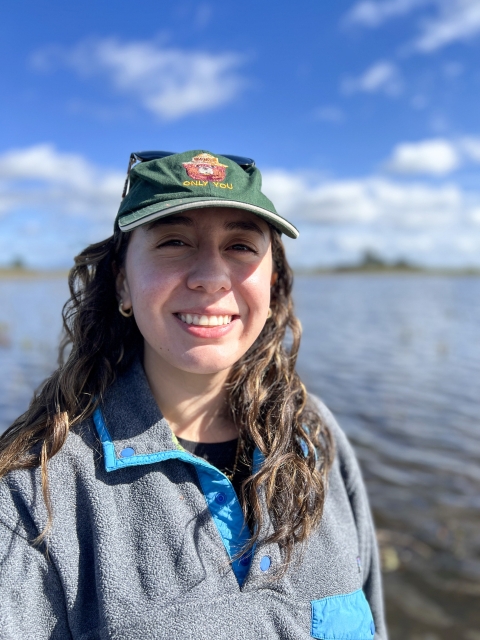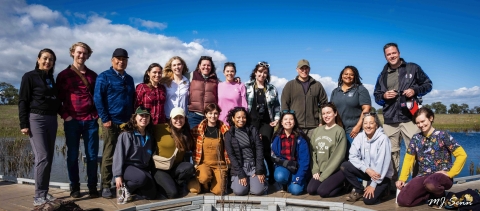Growing up in Southern California, I have always considered myself an “outdoors person.” Family hiking and camping trips were very much part of the vacation rotation – if you scroll far back enough on Facebook, you’ll likely find pictures of surly teenage me half-smiling at the top of Vernal Falls. These experiences gave me a naivety about access to outdoor spaces and the diversity of people who visit public lands. Even many of my college friends were like me in their willingness to join any spontaneous excursion, facilitating a vast community of people and resources I could tap into for gear, rides, and insider tips. My memories of “getting outside” were chock full of folks from all walks of life, enjoying the outdoors in varied ways, and I assumed this was how everyone experienced nature.
I had a rude awakening when I moved across the country to New York and became acutely aware of everything that can stand in the way of accessibility. Without a car or the community of people that shared my hobbies, I quickly realized that my lack of familiarity with my environment, alongside many of my identities, made it difficult to feel safe venturing into the unknown. I mourned the days of waking up and deciding to visit a new trail, confident in the knowledge that I knew a friend who would tag along or had been to that park often enough to know it was a place I would feel comfortable. When I started my role as a bilingual public affairs fellow via Science in the Service with the U.S. Fish and Wildlife Service, the opportunity felt like a mental tether to the spaces I had grown up in and now yearned for - places where the grass always seemed greener than the concrete jungle outside my apartment window, from which all of the Northeast’s great big outdoors were too far away to think about when juggling work and young adult life.
Driven both by a desire to see some trees and perhaps in small part inspired by how much my enthusiastic coworkers knew about wildlife, my roommate and I found ourselves without plans one weekend and decided to try out a free, introductory birdwatching walk. We hopped on a subway, wandered around a park, and left full-blown birdwatcher aficionados. Incredibly excited about this new discovery that you could, in fact, experience nature without needing to venture hours away, I had to learn more.
When I mentioned this to Martha Maciel, my fellowship supervisor, she eagerly shared her own foray into the world of birding and recommended an identification app that opened even more doors – now, I didn’t even need a guided walk to go explore on my own!
Since that first experience a few months ago, I now often go on walks through Central Park’s Ramble, looking for a new bird to identify, or point out swallows and mockingbirds sitting on fire escapes to those around me. While I felt a bit silly at first, whipping out my birding app to get a second opinion from friends about bird calls, I quickly realized folks were incredibly receptive to the activity. They were excited to learn the names of birds they often saw around their homes, workplaces, and neighborhoods, because it helped them feel a little more at place in their surroundings. On a recent road trip with my Spanish-speaking parents, I saw that same excitement in their relating of birds we were seeing to those they had grown up seeing in El Salvador.
Borrowing from those perspectives, I now think of the birds as outdoor buddies who keep me company and offer me the familiarity to feel comfortable exploring a new place. Sometimes, when New York feels especially lonely, I look up and notice a few sparrows on the edge of a building, and I feel that joy of experiencing nature as part of my day. Not everyone is able to wander off into the woods, for a variety of reasons, but we can all be reminded that wildlife is always around us. That’s why I believe the greatest lesson I’ve learned in this role, beyond how many ways you can say “pigeon” in Spanish, has been to see wildlife everywhere and to appreciate their ability to thrive in less-than-ideal circumstances.
An appreciation for the omnipresence of a creature or critter truly feels like the most accessible way to get people excited about and invested in conservation, because that passion can be cultivated anywhere. That is why there is so much power in the way information is shared. We, as people working to enhance outdoor spaces, often talk about getting folks outside but hesitate to take the practical actions that meet people where they are and consciously work around barriers to access. From bilingual monarch education at local community events (shoutout to Vanessa Morales in the Ventura Office!) to gardening tips that don’t require people to go further than their backyard, I am incredibly proud to have been part of the Pacific Southwest Communication team and their work towards an outdoors for all. In each of their efforts to make information exciting and engaging, I see an intentional step towards building that community of access that doesn’t expect a particular type of “outdoorsiness” we so often associate with loving nature. Sometimes, the first step towards advancing stewardship and protecting habitats is simply fostering a love for nature by reminding someone to look outside and marvel in the beauty of a bird that may have traveled from across the world to end up on their windowsill.











